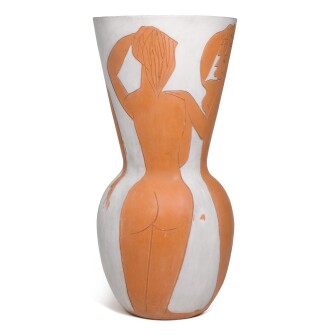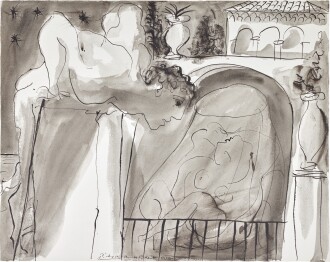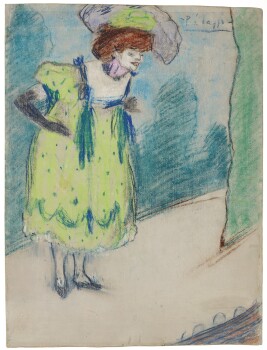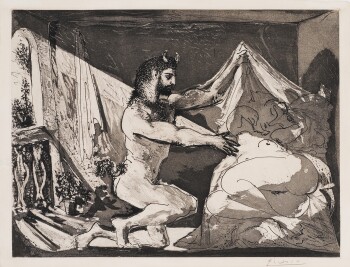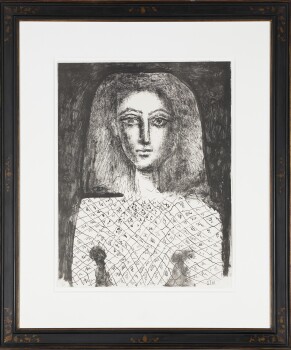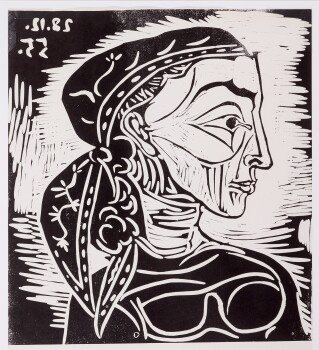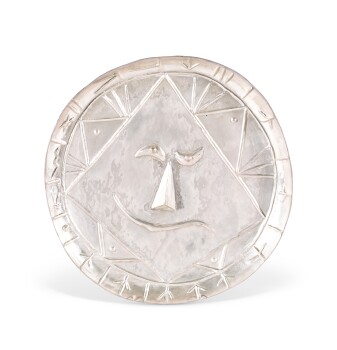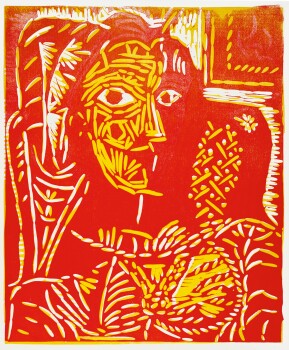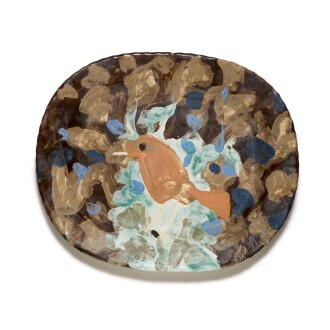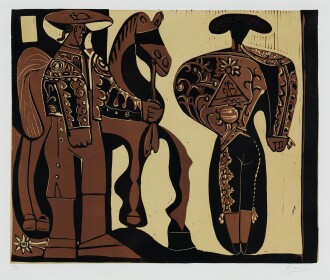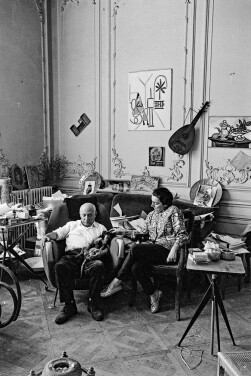
T he World of Picasso presents over 200 works spanning the artist’s entire oeuvre. Unmatched in the scope of his creativity by any other artist of his generation, Picasso produced a rich body of works that never fails to amaze, from pastels to linocuts, ceramics to silver plates. He turned his hand to virtually every medium and suffused it with his instantly recognizable yet constantly evolving style. Our online auction celebrates the enduring legacy of the inimitable Pablo Picasso.
Over sixty works in the sale come from the personal collection of the artist’s granddaughter, Marina Picasso. Marking an opportunity for her to share these private works with the rest of the world, the collection encompasses such diverse creations as Cubist sketches, experimental portraits of Jacqueline and even paint palettes, carefully preserved as relics from the creative process of this most exceptional artist.
Explore Highlights from the Auction
- 1900
- 1907
- 1936
- 1949
- 1955
- 1956
- 1958
- 1969
-
 Pablo Picasso, La diseuse. Estimate £400,000–600,000
Pablo Picasso, La diseuse. Estimate £400,000–600,000
Picasso employed pastel to ravishing effect in the years 1900-1901. While first depicting glamorous Spanish women in their finery, on his arrival in Paris he adapted the subject matter to actresses and singers in stage costume, pillars of the French demi-monde that he so delighted in depicting. The present work is a spectacular example of Picasso’s mastery of the medium: the performer’s stage make up articulates her striking features while her costume appears to be electrically illuminated in stage lights. Another example from this remarkable series is in the permanent collections of The Museu Picasso, Barcelona.
VIEW LOT -
 Pablo Picasso, Le Poussin (Baer 214). Woodcut printed by hand in dark blue and bright blue gouache. Estimate £30,000–50,000
Pablo Picasso, Le Poussin (Baer 214). Woodcut printed by hand in dark blue and bright blue gouache. Estimate £30,000–50,000
Picasso inherited a love of birds from his father, the professional painter and pigeon breeder José Ruiz y Blasco. Together, they drew their pet rock doves from life, a tradition Picasso continued throughout his prolific career. This charming chick, printed in blue, was one of several subjects Picasso experimented with while preparing illustrations for Apollinaire’s Le Bestiaire. Though this fledgling was not included in the final publication, this early woodcut has enjoyed much admiration in the collections of its previous owners Gertrude Stein, and Mr. and Mrs. John Hay Whitney.
VIEW LOT -
 Pablo Picasso, Faune dévoilant une femme (B. 230; Ba. 609). Aquatint with engraving, 1936. Estimate £35,000–45,000
Pablo Picasso, Faune dévoilant une femme (B. 230; Ba. 609). Aquatint with engraving, 1936. Estimate £35,000–45,000
Brigitte Baer praised this early, dramatic work as Picasso’s “most successful print in the Suite Vollard and one of the most beautiful in the artist’s engraved work”. A modern interpretation of Rembrandt’s 1659 etching Jupiter and Antiope, this moonlit masterpiece is believed to symbolise Picasso’s evolving relationship with Marie-Thérèse Walter. Baer suggests that it “looks back nostalgically on their [1936] stay in Juan-les-Pins”, where the lovers became parents (Baer, 1983, p. 98). Picasso, the amorous faun, peers adoringly upon the mother of his daughter Maya, seeing her in a new light.
VIEW LOT -
 Pablo Picasso, Le corsage à Carreaux (B. 601; M. 175) Lithograph. Estimate £35,000–50,000
Pablo Picasso, Le corsage à Carreaux (B. 601; M. 175) Lithograph. Estimate £35,000–50,000
Picasso became fascinated with lithography in the 1940s – around the same time he met Françoise Gilot. Inspired by Françoise’s spirit and determined to master the challenging grease-based printmaking technique, he repeatedly practiced her likeness on stone under the tutelage of master lithographer Fernand Mourlot. Mourlot noted that Picasso approached the medium boldly and confidently from the start, while most novice lithographers would tread with care. This particularly strong, yet sensitive, depiction of Françoise speaks to the artist’s passion for both the art form and his muse.
VIEW LOT -
 Pablo Picasso, Profil de Jacqueline au Foulard (Ba. 1033) Linoleum cut printed in black. Estimate £30,000-50,000
Pablo Picasso, Profil de Jacqueline au Foulard (Ba. 1033) Linoleum cut printed in black. Estimate £30,000-50,000
One of only a few impressions, this rare and important print represents Picasso’s first attempt at employing linoleum blocks for a significant work of art. Previously, he had only relied on the medium to create exhibition posters under the guidance of master printer Hidalgo Arnéra, from whom this work was acquired. Printed in 1955, this portrait depicts Picasso’s second wife and final muse, Jacqueline Roque. This relatively early portrayal celebrates her strength and demonstrates a forcefulness that softens in his more delicate portraits of the 1960’s.
VIEW LOT -
 Pablo Picasso, Visage (P. H. 1442), Silver plate. Estimate £20,000–20,000
Pablo Picasso, Visage (P. H. 1442), Silver plate. Estimate £20,000–20,000
In collaboration with esteemed metalsmith François Hugo, Picasso designed 24 glimmering silver plates, along with gold plates and medallions. Inspired by his own ceramics, which were crafted at the Madoura Pottery in sunny Vallauris, each plate honours the culture and joie de vivre of Southern France. Conceived in 1956 in a limited edition of 20, the peaceful Dormeur is one of several sleepers, or dreamers, the artist portrayed that year.
VIEW LOT -
 Pablo Picasso, Portrait de Jacqueline au Fauteuil (Ba. 1054; PP. L-033). Linoleum cut printed in colours. Estimate £35,000–45,000
Pablo Picasso, Portrait de Jacqueline au Fauteuil (Ba. 1054; PP. L-033). Linoleum cut printed in colours. Estimate £35,000–45,000
When Picasso moved to the south of France in the late 1950s, the distance from Mourlot’s lithographic press in Paris was the primary motivation for him to explore the linoleum cut as a creative outlet. Therefore, it is fitting that Jacqueline, whom he met at the Madoura Pottery in 1952, be the subject of this early work in the medium. Frustrated by the extreme effort it took to create this image from several linoleum blocks, Picasso eventually developed the “reduction” method that allowed him to create a multi-color linocut using just one block.
VIEW LOT -
 Pablo Picasso, Visage au nez noir (A. R. 609). Terre de faïence pitcher. Estimate £15,000–20,000
Pablo Picasso, Visage au nez noir (A. R. 609). Terre de faïence pitcher. Estimate £15,000–20,000
Picasso’s passion for portraiture extended to the colorful ceramics he designed at the Madoura Pottery. Having mastered the human form on paper and canvas, the artist eventually sought a greater challenge in clay. This 1969 pitcher Visage au nez noir is an especially expressive vessel, decorated with mesmerizing swathes of colour and finely incised lines that render a bright-eyed and cheerful face.
VIEW LOT

- Pablo Picasso, 'Le Voyeur', 1933. Estimate £400,000-600,000
- Pablo Picasso, ‘L'entrée Aux Arènes’, 1900. Estimate £260,000-360,000
- Robert Doisneau, ‘Les Pains De Picasso’, 1952. Estimate £4,000-6,000
- Pablo Picasso, 'Palette', 1961. Estimate £4,000-6,000
- Pablo Picasso, ‘Projet D'affiche’, 1951. Estimate £24,000-28,000
- Pablo Picasso, ‘Femme Espagnole sur fond orange – Recto, Profil Gauche – Verso’. Estimate £24,000-28,000
- Pablo Picasso, ‘Scène Médiévale’, 1951. Estimate £18,000-25,000
- Pablo Picasso, ‘Etude pour trois femmes’, 1907-1908. Estimate £30,000-40,000
- Pablo Picasso, ‘Carreau (Buste De Faune)’. Estimate £8,000-12,000
- Pablo Picasso, ‘Tête Circulaire’, 1956. Estimate £10,000-15,000
Birds
Picasso’s father was a breeder of pigeons and he encouraged his son to paint these feathered friends at a young age. Birds continued to play a significant role in Picasso’s life and art, as demonstrated by their frequent appearance in his paintings, drawings and ceramics. His drawing Dove of Peace was selected for the International Peace Conference in 1949, the same year that he named his daughter Paloma, the Spanish word for ‘dove’. Our varied selection of works on paper and ceramics featuring this favoured motif is led by the exquisite 1907 woodcut Le Poussin, once in the collection of Gertrude Stein.

Bull Fighting
Picasso’s earliest surviving painting is a small portrait of a picador on a horse, made when he had just turned eight. His Spanish heritage – and specifically the cultural institution of bull-fighting – would continue to inform his production throughout his life. He identified with the bull-fighter, recognising their shared spaces of performance, creativity and courage. However, he would frequently infuse the combat of the bullfighting arena with mythological elements, elevating it into a world saturated with heroism and fantasy. Picasso once commented: "If all the ways I have been along were marked on a map and joined up with a line, it might represent a Minotaur."

Autobiography
By the time of the Second World War, Picasso was an international celebrity and the world’s most famous artist. The press hotly pursued him, and he welcomed photojournalists such as David Douglas Duncan into his home to chronicle his life and work. Within our selection of wonderful works, we can identify the artist’s increasing preponderance with his identity as an artist: his particular manual uniqueness and indeed his own legacy. Picasso is quoted as once saying: "When I was a child, my mother said to me, “if you become a soldier, you'll be a general. If you become a monk, you'll end up as the Pope”. Instead, I became a painter and wound up as Picasso."
Jacqueline
Picasso produced more images of his second wife Jacqueline than any other muse in his life. Jacqueline provided Picasso with an extraordinary new zest for life and industry which animated the final twenty years of his production. While Picasso’s celebrated series of 15 paintings depicting Les Femmes d’Alger. derives from Delacroix’s The Women of Algiers, it is in fact inspired by Jacqueline. Picasso playfully explained: “Delacroix had already met Jacqueline”.


